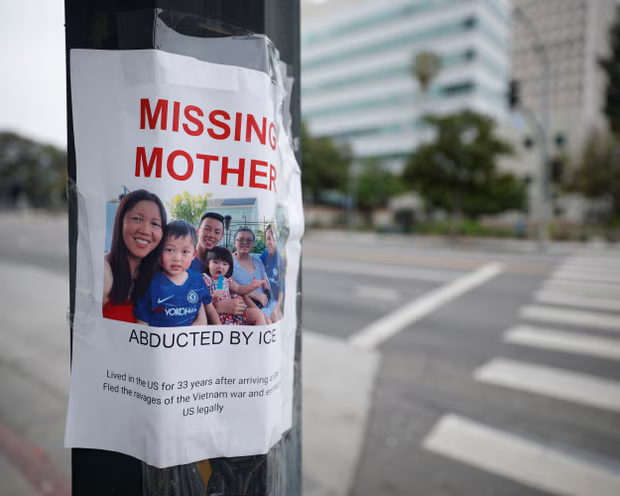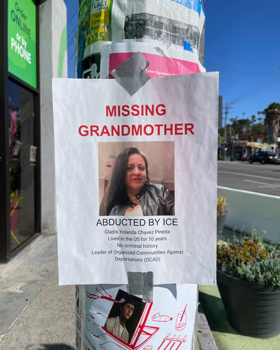Vanished Without a Trace How Haunting Posters Across Los Angeles Reveal the Silent Suffering of Immigrant Families
In neighborhoods across Los Angeles, a new kind of message is catching the eyes—and the hearts—of passersby. Among the usual clutter of event flyers, yard sale ads, and comedy show announcements, a chilling series of handmade posters have emerged, each one declaring the same bold message at the top:
“Missing Son.” “Missing Father.” “Missing Grandmother.”
But these aren't typical missing person notices. They are part of a grassroots campaign shedding light on a quieter crisis—the disappearance of immigrant families, abducted not by criminals, but by a government agency known as ICE (Immigration and Customs Enforcement).
A Campaign of Quiet Resistance
Titled “Abducted by ICE,” the posters showcase real faces and real stories. One poster shows Kilmar Ábrego García, a Maryland father deported to El Salvador without a hearing—a mistake even federal authorities admitted. Another features Gladis Yolanda Chávez Pineda, a grandmother from Chicago taken during a routine immigration check-in while applying for asylum. A third poster displays Andry Hernández Romero, a makeup artist who fled Venezuela and was sent to an El Salvador mega-prison based solely on tattoos—an accusation his loved ones vehemently deny.
Each story is more than a headline. It’s a life upended, a family torn apart, a person erased without due process. The posters starkly state:
“Did not receive constitutional protections.”
“Currently being held in detention.”
“No criminal history.”
The Artists Behind the Movement
The campaign started as a small effort by two friends—Ben, 28, a designer, and Sebastian, 31, who immigrated from Colombia. Frustrated by mainstream portrayals of immigrants and inspired to humanize their stories, the two began wheat-pasting the posters across neighborhoods like Silver Lake and Echo Park.
“It hit me that these aren’t just names or statistics,” said Ben. “These are people—someone’s son, someone’s abuela. People who live down the street. We had to show that.”
Their message quickly spread. Ben shared the poster designs digitally, and soon others joined in. One elderly woman reportedly stood crying in front of a poster. “That moment made it real,” he said. “People are connecting. They understand this is about human dignity.”
The Message Goes Beyond the Posters
As protests against federal immigration policies grow across Los Angeles, this campaign has become part of a broader movement. Street art, stenciled messages, and counter-propaganda have joined the posters to redefine what ICE means to the community. Phrases like:
“Illegal Country-wide Embarrassment”
“Institution of Child Endangerment”
“Undocumented Hands Feed You”
...have been spray-painted on sidewalks, storefronts, and public spaces. Each one offers a pointed critique of immigration enforcement’s human cost.
Voices of Solidarity from the Margins
Sydney, 29, who works in the LA music industry, created one of the more striking visuals—a stylized poster reading “Undocumented hands feed you,” accompanied by the image of a migrant farm worker. She couldn’t attend street protests due to her job, so this was her contribution.
“I grew up with immigrant relatives. My roots are Latina. This is personal,” she said. “I wanted to create something beautiful but powerful. Something you don’t just scroll past.”
Her poster was printed and posted by friends across LA’s more affluent areas, from Silver Lake to the Arts District, places not always connected to the harsh realities immigrants face.
A Contrast to the Chaos
This creative resistance stands in stark contrast to sensational images in the media of downtown protests, military deployments, and street fires. While some corners of LA were indeed rocked by unrest, the vast majority of the city moved through its daily rhythm—sunlit, traffic-packed, and full of ordinary life.
Yet even in calm, the posters whisper a disturbing truth: lives are being shattered silently, behind closed doors and locked detention centers. While loud demonstrations make headlines, these paper-and-glue messages offer a softer but no less powerful rebellion, one that tugs at conscience and demands empathy.
Not Just Protest, but Personal
Every flyer, every stencil, every taped-up photograph carries a plea—not just for policy change, but for recognition of humanity. The creators want viewers to ask: What if this was my family? My neighborhood? My story?
These posters are not part of a political campaign or organized NGO drive. They are neighbor-to-neighbor acts of solidarity, raw, unfiltered, and deeply human.
Conclusion
In a city often portrayed as a battleground of ideology, the “Abducted by ICE” campaign has emerged as a soulful reminder of the stakes behind immigration policies. It’s not just about borders or paperwork—it’s about mothers, fathers, artists, workers, and families whose lives are changed forever in an instant.
In the quiet corners of Los Angeles, pasted to a pole or fluttering against a brick wall, these haunting posters continue to speak—not through noise, but through presence. And in that presence, they refuse to let these people be forgotten.

